When it comes to omnipresent brands, few modern companies hold a candle to the name recognition and influence held by Apple. This wasn’t always the case however, and there was a time in the not-so-distant past when the company was in serious danger of going under.
But thanks to a combination of brilliant product and marketing strategies, Apple turned themselves around, dominated their market, created new markets, and revolutionized the tech industry.
Let’s dive into how they did it and what you can learn from them, regardless of what kind of business you work for. But first…
Claim Your Marketing Strategy Template
Marketers with a documented strategy are more successful. And since you’re here, isn’t learning how to plan a successful strategy what it’s all about? Download this clear and simple template to get started:
Apple’s History: From Garage to Macintosh
You’ve likely heard the story before: Steve Jobs and Steve Wozniak, strapped for cash and full of big ideas, founded Apple in Jobs’ parents’ garage and began building the first Apple computers on a small suburban street in Los Altos, California.
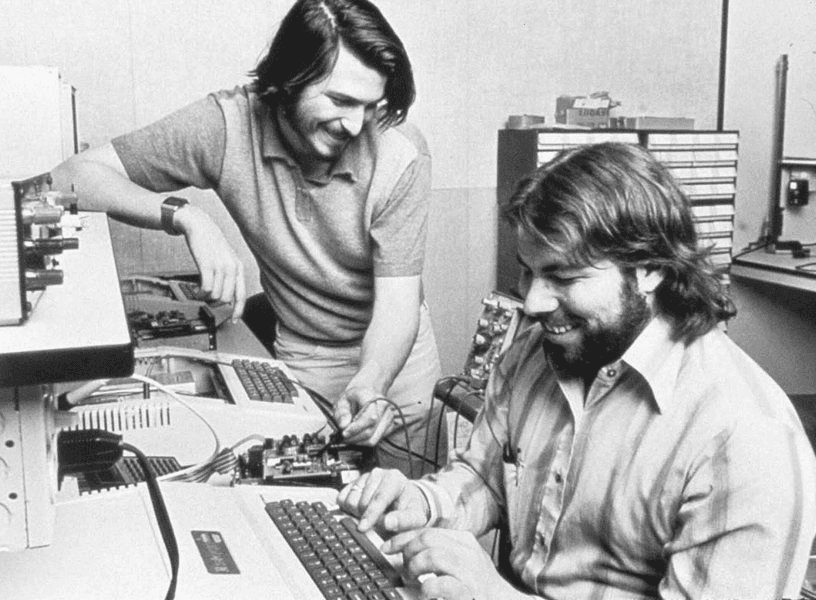
While Wozniak may dispute some of that story, the gist is true. The duo met in 1971, and by July 1976 they launched the Apple I, which went on sale for $666.66 and only had 4KB of RAM (2,000,000 times less than modern computers). Within a year the Apple II was released as the first personal computer for the mass market, and two years later the Apple III was introduced.
These early Apple computers were acclaimed for their innovative designs, user-friendly interface, and their brand’s appeal to creativity, which materialized in both their marketing and the products themselves.
Worth noting: One of Apple II’s defining features was its ability to display color graphics, which prompted Apple to redesign their logo to have a spectrum of colors. This logo remained a part of Apple’s corporate logo until 1998.
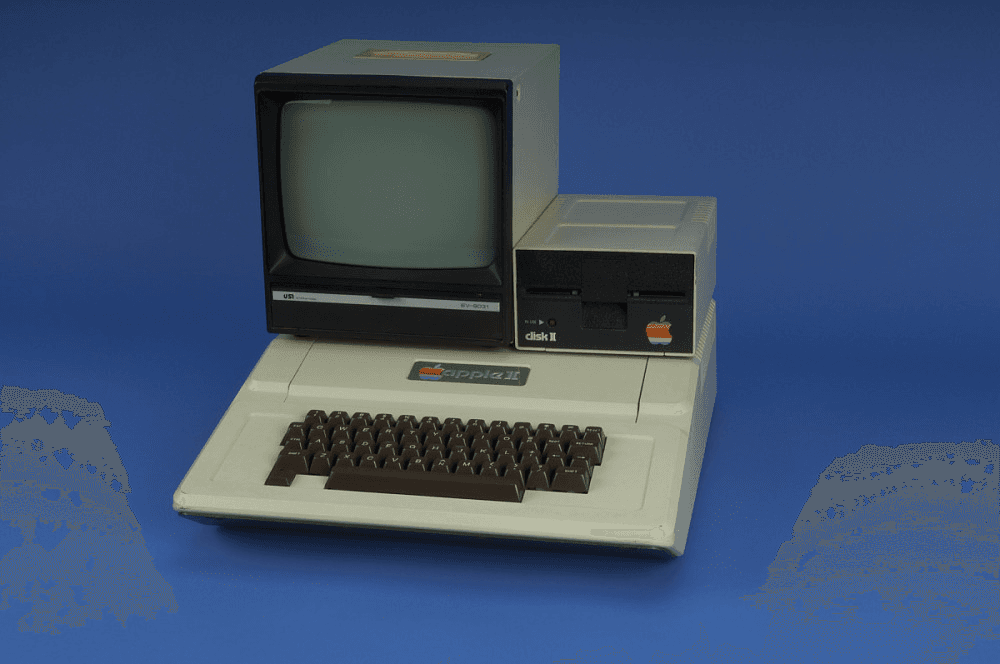
In the early years, these Apple computers competed with IBM and Microsoft, with Apple carving out a niche in education and with creatives. Preparing for the highly-anticipated release of the Apple Macintosh in 1984, Apple’s internal strategy documents stated their primary marketing goal as being to “Establish Macintosh as the third industry standard product in the marketplace.” The other two products they cited as industry standards at the time were the Apple II(e) and the IBM-PC.
Quoting those same documents, “It is our premise that we will only get to introduce this product once. We have an extraordinary product. We must surround that product with excellent service, support, applications software.”
To support the Macintosh rollout which insiders at the time viewed as vital to the long-term success of Apple, the company purchased time in one of the all-time most sought after ad slots: the Super Bowl. Apple hired Ridley Scott, renowned director of movies such as “Alien” and “Blade Runner” to direct their commercial, and he made them a masterpiece.
Apple’s 1984 Super Bowl commercial is one of the all-time most recognizable commercials, and it has been called the greatest Super Bowl ad ever. It was incredibly innovative and forward-thinking for the time, with the tagline “Why 1984 won’t be like ‘1984’” playing on George Orwell’s dystopian novel to show that Apple’s products, specifically the Macintosh, will be used for freedom rather than control.
Despite this marketing coup, the Macintosh’s rollout failed to meet the sky-high expectations set for it beforehand. Though they sold 70,000 units in the first three months, by the end of the year they were selling less than 10,000 a month. Cheaper, more reliable and functional computers from IBM relegated Apple mainly to education and desktop publishing.
Steve Jobs left the next year to develop his own computer, and while Macintosh and its successors would see major success in the next decade, a combination of overpriced products and increased competition conspired to gradually reduce Apple’s market share.
Turning the Company Around
By the 1990s, Apple was down in the dumps. The success of Microsoft Windows, a price war with Compaq, and a confusing product line (at one point the Macintosh lineup was divided into 5 mostly similar but differently named and branded computers) combined to push Apple further down the ladder of market share.
Apple was looking for a miracle, and it seemingly got one. The company purchased Jobs’ NeXT software company (the same one he founded in the mid-80s), and by 1997 Jobs would be named the interim CEO of Apple.
Fun fact: It has been reported that Apple was 90 days away from bankruptcy when Jobs took over as CEO.
Jobs immediately set out to revitalize the company he co-founded all those years ago. He refocused target markets by ditching the so-called “Macintosh clones,” created an alliance with Microsoft to get Office software on Mac, and got Apple back to doing what they do best: creating elegantly designed products that are easy and intuitive to use.
Looking toward the new Millenium, Jobs and his company realized they needed to adjust their focus, and released an all-in-one computer which harkened consumers back to the original Macintoshes, the iMac.
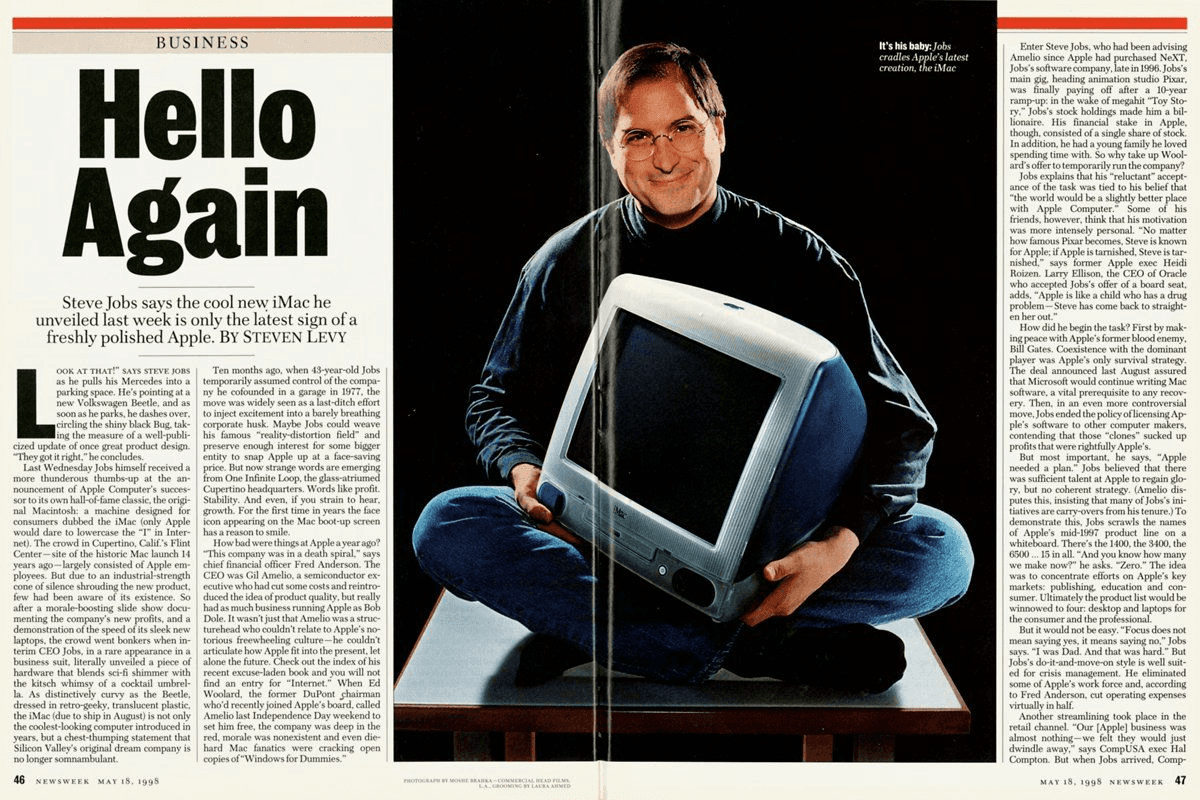
The Apple Store, iMovie, and iTunes, three products still used today, were released within this time period. In October 2001, Apple released the iPod, which revolutionized the way people listen to music.
Apple gradually picked up momentum over the next decade by leaning into their ability to create products that appeal to the consumer market with beautiful design and user-friendly operating systems, and each new Apple product launch became a huge event.
At the 2007 Macworld Expo, Jobs announced the release of the iPhone, a complete game-changer for the personal technology industry. The product sold 270,000 units in its first 30 hours of sales, and never looked back.
The company began making their products slimmer and more sleek, and with the release of the iPad in 2010 Apple had developed a stranglehold on the personal technology market.
Throughout this time Apple’s marketing focused on the value their products could provide, and their sleek visual identity has become one of the most easily-recognizable visual brands of the 2000s. In addition, their “Think Different” campaign has inspired a whole new generation of Apple users.
Apple is now one of the largest companies in the world. iPhone, iPad, iPod, Mac, Apple TV, Apple Music, and countless other products have placed Apple at the top of the tech market, but one thing has not changed since the founders designed their first computer: Apple creates elegant, user-centric products that provide their engaged customer base an experience they love and want to share with others.

So, how did they do it? What can you take away from Apple’s continued success?
Recent Product Launches And Marketing Strategies
Apple’s innovation isn’t slowing down. With the launch of the iPhone 15 series in 2023, Apple continued to redefine the smartphone experience, offering models with advanced camera systems, longer battery life, and enhanced performance. These features appeal to a wide range of consumers, ensuring that Apple remains a leading player in the smartphone market. But that’s not all—the iPhone 15 Pro models have set new standards in mobile technology, with cutting-edge features like enhanced photography tools, improved durability, and the latest A17 chip.
In addition to the iPhone 15, Apple also unveiled the Apple Watch Series 9 and Apple Watch Ultra 2. These models offer advanced health tracking features, from ECG monitoring to sleep tracking, as well as a sleek new design. The Ultra model is designed for extreme sports enthusiasts, continuing Apple’s push into the premium wearable market.

But the most exciting development came in June 2023, when Apple announced the Apple Vision Pro—a revolutionary mixed-reality headset. This new product marks Apple’s entry into spatial computing, blending the physical and digital worlds to deliver immersive experiences for both entertainment and professional use. The headset is expected to be a game-changer in fields like gaming, productivity, and education, solidifying Apple’s position at the forefront of cutting-edge technology.
6 Lessons You Can Learn From Apple’s Approach to Marketing
So, you want to know how to follow the marketing strategies underlying Apple’s continued success? It won’t happen overnight, but consistently following these 6 lessons can help you establish your brand and find major success for your business.
1. Keep Your Branding Consistent
One of the reasons Apple is such a recognizable brand is its consistent visual identity. When you see an Apple ad, you don’t need to look for the logo—you know exactly who it is. This consistency in branding has made Apple a household name.
To create the same recognition for your brand, invest in a solid visual identity and make sure it’s applied everywhere. Some ways to ensure consistency include:
- Expanding your design team
- Creating a comprehensive brand style guide
- Implementing a review process to maintain uniformity across all platforms

Being consistent makes it easy to create an engaged base of fans for your product, and grows brand recognition exponentially over time.
2. Make Things Simple and Easy to Understand
Steve Jobs made it clear when he returned to Apple that too many product options can confuse consumers. Apple’s approach has always been about simplifying product lines, offering just the right amount of variety without overwhelming the consumer. Take the iPhone—while it has evolved over time, Apple has kept the product line simple and streamlined.

When you simplify your product offerings, you also make it easier to craft clear, targeted marketing messages. A simpler product line allows you to focus on the core features that matter most to your customers, making your marketing more effective and your products easier to understand.
Great Product + Clear Marketing = Success
3. Help Your Customer’s Share Your Values
When people buy Apple products, they feel like it reflects something about who they are and what they value in the tech they choose to use. It appeals to people’s desire to feel a part of something bigger than themselves, and their marketing dating all the way back to that 1984 Super Bowl commercial has framed Apple as a worthy cause to support.
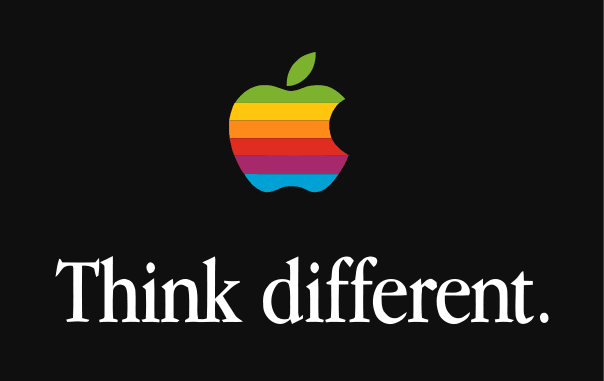
When you make it clear what you stand for or what you value, customers will have no qualms about paying a little extra to support those values.
Apple’s positioning as a brand ushering in a better future has served them well in this regard, and you can do this for your brand too.
An easy way to get started is to build out your About Us page with company values or high-level missions. Once you have that content, it’s easy to share across departments and make those values a major part of everything you do.
By sharing your values you will make it easy for customers to feel like your products help them express their own values, and you’ll get yourself a solid group of dedicated customers in the process.
4. Build a Community Around Your Brand
Diehard Apple fans do a lot to market the Apple brand without knowing they’re doing it; they’re just passionate about the brand. Apple products have become a major part of life for many people, and Apple’s marketing now relies heavily on word-of-mouth and the support of their community of dedicated users.
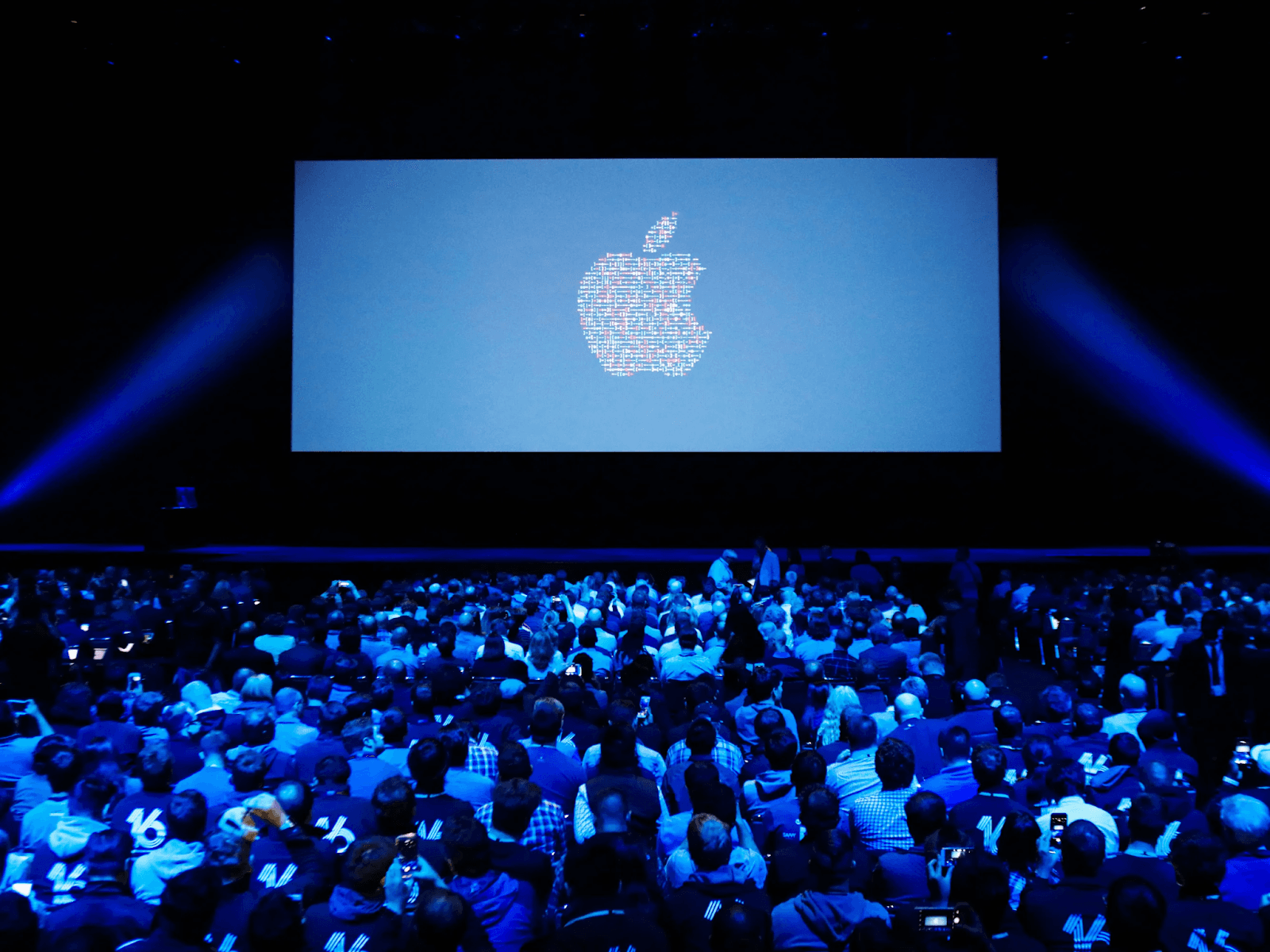
Apple did this early on by holding events (think product launch announcements) where they could get the media and dedicated customers excited about new products, and then connecting with that community in a meaningful way with their marketing.
You can build a community around your brand and turn customers into advocates, even if you don’t have the resources or buzz for a massive product launch party.
Slack groups, forums, regular events, presence at trade shows, webinars, and other customer-first operations can all help you build that kind of community. The key here though is to provide value through whichever method you choose. If you can consistently provide value to your customers through events like these, they will come back time and again to buy your products.
5. Leverage Product Placement
Apple understands the value of advertising, but they also understand product placement. They’re a part of the biggest events, in the pockets of the biggest celebrities, and their brand has almost taken on a life of its own in popular culture over the last few decades.

One example was Phil Dunphy from Modern Family, who was frequently seen using an Apple iPad. This subtle product placement not only solidified Apple’s presence in popular culture, but it also created a sense of authenticity around the brand. Viewers naturally associated Apple with the modern, tech-savvy, and relatable character of Phil Dunphy, making it more likely they’d gravitate toward Apple products themselves.
If you haven’t started with influencer marketing, affiliate marketing, or relationship marketing, these are easy areas to begin leveraging existing relationships and other brand’s audiences to raise the visibility of your products. Influencer marketing has been picking up steam lately as an incredibly effective way to get your product in front of the audiences you want.
Whether it’s through product reviews, influencer endorsements, affiliate blog posts or other opportunities, leverage these channels to get your product in front of the right audience and then reap the rewards when those audiences tune in to your brand.
6. Set Prices According To Value (And Offer More Value Than Anyone)
Clearly, price is a major aspect of any customer’s buying decisions. It isn’t, however, the end-all be-all when someone is considering purchasing your product.
There are plenty of phones lower in price than the iPhone, but Apple’s uncompromising commitment to quality and providing value to their users has enabled them to charge more and have millions of people happy to pay for it.
This doesn’t mean you can charge exorbitant prices for no reason. What it does mean though, is that you should know the value of your product and don’t be afraid to charge relative to the value you’ll provide.
If the value is there compared to your competitors and you can show that value to prospective customers, don’t worry about being priced out. Keep proving how valuable you and your product or service are and you’ll keep selling.
Apple’s Marketing Mix
For a more simplified explanation of Apple’s success, here’s a look the company’s general marketing mix.
Product
Apple offers a range of products that seamlessly integrate into an ecosystem, carefully designed based on in-depth customer research. This cohesive approach ensures that customers not only stay loyal but also become brand advocates. Here are some of Apple’s core product lines today:
- Mac (MacBook Air/Pro, iMac, Mac Pro)
- Apple Software (macOS, iCloud, Final Cut Pro, Apple Music, iMessage)
- iPhone (including the iPhone 15 and iPhone 15 Pro series)
- iPad (iPad Mini, iPad Air, iPad Pro)
- Apple Watch (Series 9, Ultra, SE)
- AirPods (Pro, 2nd generation, Max)
- Apple TV (Apple TV 4K, Apple TV+)
Apple continues to push the envelope with innovation while maintaining a core focus on user experience and seamless integration across all its products, making it difficult for customers to leave the ecosystem.
Price
Apple maintains its premium pricing strategy, capitalizing on its brand’s reputation for innovation and quality. Customers are willing to pay a premium for Apple’s cutting-edge technology, aesthetic designs, and superior user experience. This pricing strategy has enabled Apple to charge higher than many competitors and still attract millions of loyal customers who value the overall experience over the cost. Whether it’s the flagship iPhone 15 Pro or the MacBook Air M2, Apple’s pricing strategy consistently places the brand at the higher end of the tech market.
Place
Apple controls its distribution with selective retailing, maintaining strict guidelines about who can sell its products. The company’s exclusive distribution channels allow Apple to ensure consistent customer experiences while minimizing distribution costs. Apple’s primary sales channels include:
- Apple Stores (Both brick-and-mortar and online)
- Apple’s Official Website and App Store (Offering a seamless purchasing experience and services like AppleCare)
- Authorized Retailers (Best Buy, Target, and select carriers)
- Apple’s Subscription Services (Apple TV+, Apple Music, iCloud)
Apple’s exclusive approach to distribution keeps the focus on high-quality service and reduces the chances of product cannibalization by unauthorized sellers.
Promotion
Apple’s promotional strategy is highly impactful, utilizing advertisements, keynote events, and digital marketing to engage customers. The company effectively uses a combination of digital advertising, billboards, and TV commercials, ensuring a strong visual presence across multiple channels. Additionally, Apple’s keynote events (like the WWDC and the September launch events) have become cultural phenomena, eagerly anticipated by tech enthusiasts, the media, and consumers worldwide. These events not only promote new products but also strengthen Apple’s brand identity and showcase the company’s vision for the future.

One of Apple’s most significant promotions is its “Shot on iPhone” campaign, highlighting the powerful camera capabilities of the iPhone by featuring stunning photography from everyday users, strengthening the emotional connection with customers.
Continued Success
When Steve Jobs returned to Apple in the late 1990s, the company was on the brink of collapse. Jobs revitalized the company by focusing on innovation, quality, and providing products that were both intuitive and elegant. He helped transform Apple into a design-driven powerhouse that continues to innovate across product lines.
Even after Steve Jobs’ passing in 2011, Apple’s current CEO Tim Cook has successfully continued the company’s growth by building on the strong foundation laid by Jobs. Under Cook’s leadership, Apple has grown even further with the launch of services like Apple Pay, Apple Music, and Apple TV+, allowing the company to diversify and secure its future.
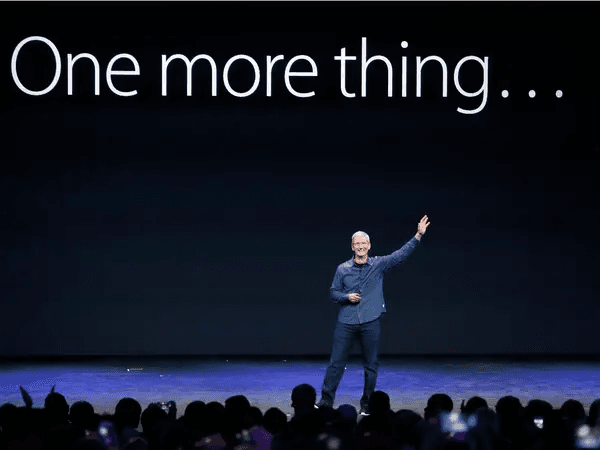
Apple’s Success Was Not by Mistake
I would like to leave you with three quotes from Steve Jobs himself.
“Great things in business are never done by one person. They’re done by a team of people.”
If you want to grow a timeless brand, you can’t do it alone. Embracing teamwork enables you to empower those around you to commit themselves and accomplish something great.
“Your work is going to fill a large part of your life, and the only way to be truly satisfied is to do what you believe is great work. And the only way to do great work is to love what you do. If you haven’t found it yet, keep looking. Don’t settle. As with all matters of the heart, you’ll know when you find it.”
This quote speaks for itself.
<em”>“I want to put a ding in the universe.”
This kind of thinking is what helped Apple become what it is today.
If you want to make a major difference, don’t be afraid to think big. Be bold, think huge thoughts, and then make it happen one piece at a time.
Now, it’s time to go put your own ding in the universe. Why wait?
